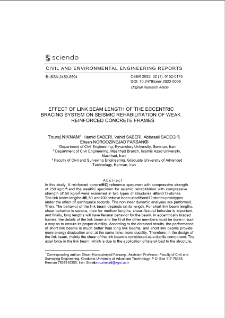Zielonogórska Biblioteka Cyfrowa udostępnia 65 391 obiektów cyfrowych
Obiekt
Tytuł: Effect of Link Beam Length of the Eccentric Bracing System on Seismic Rehabilitation of Weak Reinforced Concrete Frames
Autor:
Niknam, Touraj ; Saberi, Hamid ; Saberi, Vahid ; Sadeghi, Abbasali ; Noroozinejad, Farsangi Ehsan
Data wydania:
Typ zasobu:
Współtwórca:
Tytuł publikacji grupowej:
Abstract:
In this study, a reinforced concrete (RC) reference specimen with compressive strength of 250 kg/cm2 and the weak RC specimen for seismic rehabilitation with compressive strength of 150 kg/cm2 were examined in two types of structures with 6 and 12-stories. The link beam lengths of 50, 80, and 100 cm have been used in 6 and 12-stories prototypes under the effect of 7 earthquake records. The nonlinear dynamic analyses are performed. ; Then, the behavior of the link beam depends on its length. For short link beam lengths, shear behavior is serious, then for medium lengths, shear-flexural behavior is important, and finally, long lengths will have flexural behavior for the beam. In eccentrically braced frames, the details of the link beam and the fit of the other members must be done in such a way as to ensure its proper ductility. ; According to the obtained results, the performance of short link beams is much better than long link beams, and short link beams provide more energy dissipation and, at the same time, more ductility. Therefore, in the design of the link beam, mainly the shear of the link beam is considered as a ductile component. The axial force in the link beam, which is due to the application of lateral load to the structure, reduces both the bending capacity and the inelastic deformation capacity of the link beam, so it can be explained that in steel eccentric braces, the link beam is symmetrical between the two main components of the brace and it can affect the strength of the structure against lateral loads.
Opis:
tytuł dodatkowy: Prace z Inżynierii Lądowej i Środowiska
Wydawca:
Zielona Góra: Oficyna Wydawnicza Uniwersytetu Zielonogórskiego
Format:
Identyfikator zasobu:
DOI:
Strony:
Źródło:
Civil and Environmental Engineering Reports (CEER), no 32, vol. 1
Jezyk:
Licencja CC BY-NC-ND 3.0:
Prawa do dysponowania publikacją:
Biblioteka Uniwersytetu Zielonogórskiego
Kolekcje, do których przypisany jest obiekt:
- Zielonogórska Biblioteka Cyfrowa > Repozytorium > Jednostki organizacyjne > Wydział Budownictwa, Architektury i Inżynierii Środowiska
- Zielonogórska Biblioteka Cyfrowa > Repozytorium > Typy utworów > Artykuły
- Zielonogórska Biblioteka Cyfrowa > Repozytorium > Czasopisma naukowe i serie wydawnicze UZ > Civil and Environmental Engineering Reports (CEER) > Civil and Environmental Engineering Reports (CEER) (2022)
Data ostatniej modyfikacji:
6 lip 2023
Data dodania obiektu:
30 mar 2023
Liczba wyświetleń treści obiektu:
160
Wszystkie dostępne wersje tego obiektu:
https://zbc.uz.zgora.pl/publication/79965
Wyświetl opis w formacie RDF:
Wyświetl opis w formacie OAI-PMH:
| Nazwa wydania | Data |
|---|---|
| Effect of Link Beam Length of the Eccentric Bracing System on Seismic Rehabilitation of Weak Reinforced Concrete Frames | 6 lip 2023 |
Obiekty Podobne
Saberi, Hamid Saberi, Vahid Sadeghi, Abbasali Pooyasefat, Abbas Noroozinejad Farsangi, Ehsan Kuczyński, Tadeusz - red.
Niyonyungu, Ferdinand Noroozinejad, Farsangi Ehsan Kuczyński, Tadeusz - red.
Hosseinimehrab, lham Sadeghi, Abbasali Noroozinejad Farsangi, Ehsan Kuczyński, Tadeusz - red.
Błaszczyński, Tomasz Wielentejczyk, Przemysław Błaszczyński, Maciej Pijanowski, Filip Kuczma, Mieczysław - red.
Grzonka, Aleksandra Kuczyński, Tadeusz - red.
Nawrot, Grzegorz Kuczyński, Tadeusz - red.
Pirmoghan, Hamid Khoshravi, Hossein Sadeghi, Abbasali Pouraminian, Majid Noroozinejad, Farsangi Ehsan Kuczyński, Tadeusz - red.
Nowogońska, Beata Kuczyński, Tadeusz - red.

